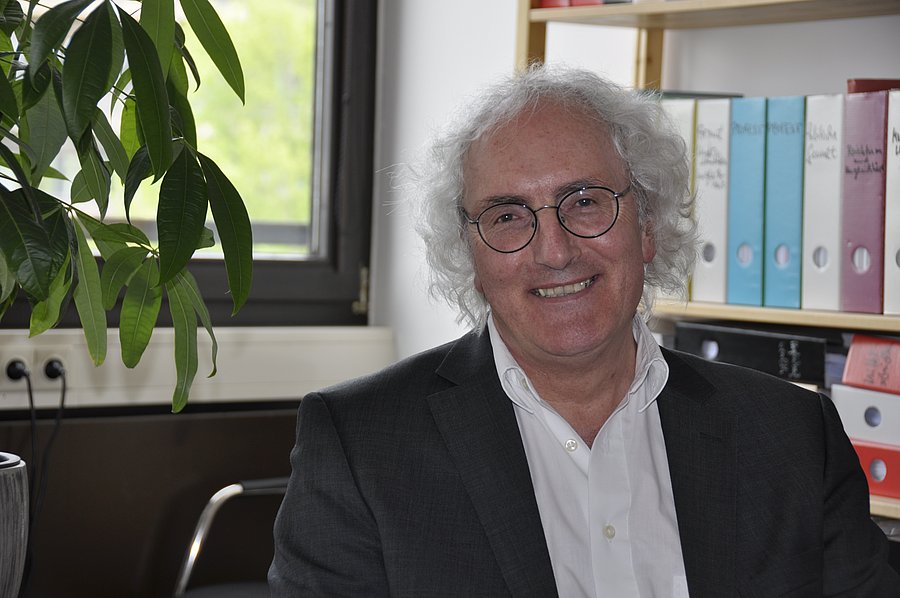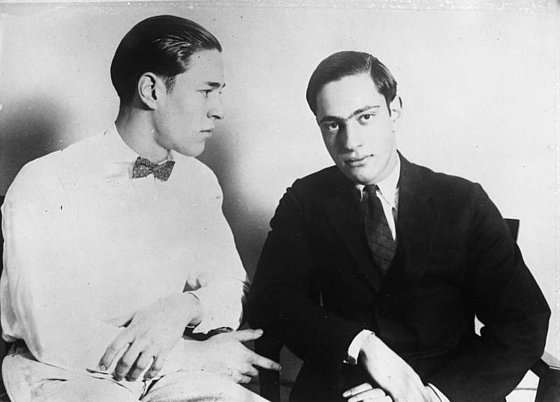
The perfect murder
Prof Dr Peter Imbusch/ Sociology of Politics
Photo: UniService Transfer
The perfect murder
Sociologist Peter Imbusch on a supposedly perfect murder and the debate about the death penalty in the USA
On 21 May 1924, two students killed an unsuspecting boy. Their motive: they wanted to commit the perfect murder. This case played an important role in the debate about the death penalty in America, didn't it?
Imbusch: Yes, but something else is worth mentioning first. Nathan Leopold Jr. and Richard Loeb - 19 and 18 years old respectively at the time of the crime - wanted to commit a perfect murder, whereby 'perfect' in this case did not mean achieving the ultimate goal, but rather a murder that could not be solved - i.e. that went unpunished. This is why the media often spoke sensationalistically of the "crime of the century", even though the century was not yet that old at the time and the murder itself was quite unspectacular. The case gained its significance for the discussion about the death penalty in the USA as a kind of trick of history. It was thanks to the skilful defence strategy of Clarence Darrow, the lawyer hired by the parents, that the death penalty, which was highly likely in this case and at that time in the USA, could be averted for the two offenders.
Nathan Leopold and Richard Loeb were regarded as extremely intelligent young men and believed that they had already achieved the higher form of existence. Did megalomania play a role here?
Imbusch: Perhaps megalomania, but even more so an elitist arrogance. They both came from rich, German-Jewish homes, lived in a wealthy neighbourhood of Chicago, were considered intelligent and actually led a good life with bright prospects for the future, but apparently felt something like bourgeois boredom. Throughout their socialisation, they cultivated a habitus of natural superiority over their environment. This was further reinforced by Leopold's obsession with Nietzsche's philosophy and his supermanism. Basically, he also saw himself as a kind of superhuman who stood outside of law and order, to whom no moral standards applied and who could restrict the freedom of movement of ordinary people at will. This even applied to murder, which he considered acceptable and which gave him pleasure.
Added to this was a toxic homoerotic relationship with Loeb, who often indulged in purposeless, destructive behaviour - such as stealing cars, setting fires or smashing windows - and had an early career in petty crime without being caught. Loeb liked to play with fire and kept upping the stakes. His offences gave him an intense high. For his vandalism, he could rely on Leopold's followers, who also gave him the feeling that he was a true master criminal. Psychologically speaking, they were a 'perfect match', as they say today.
This mix of fantasies of superiority, self-centredness and lack of empathy, nihilistic philosophy, wild crime stories and misguided love ultimately led both of them to commit the 'perfect crime'. They were not interested in the murder itself, which was merely an experiment for them and completely random, but in the idea of being able to get away without punishment. Murder without motive, without passion, unprovable and without consequences - this is what Leopold and Loeb had in mind when they murdered 14-year-old Bobby Franks on 21 May 1924.
How did the idea of murdering 14-year-old Bobby Franks come about?
Imbusch: After all, Leopold and Loeb believed that they were infallible. They had been planning the crime for months and had also devised strategies to cover it up. One day the time had come. Bobby Frank's victim was purely a victim of chance, he was simply in the wrong place at the wrong time; it could have been anyone else.

Richard Loeb (left) and Nathan Leopold (1924)
Photo: CC BY-SA 3.0 en
How did the deed go down?
Imbusch: On 21 May 1924, Leopold and Loeb finally put their plan into action. They drove randomly through the city in a hire car to find a suitable victim, concealing the number plates. Late in the afternoon, they were about to give up when they came across Bobby Franks, who was actually a distant relative and neighbour, and lured him into the vehicle under a pretext. There, Loeb first struck him down with a chisel, then they gagged and suffocated him together in the back seat. After Leopold and Loeb had hidden the body in a ditch under railway tracks outside Chicago, but had first cauterised his face with acid to make identification more difficult, the victim's family received a ransom demand of 10,000 US dollars. The idea was to fake a kidnapping. So far, everything went according to plan and the very next day Loeb's wish that the media in Chicago would report on the boy's disappearance was fulfilled. But Bobby Franks' father alerted the police and even before the family had raised the ransom money, railway workers found the body by chance. Now terms such as 'corpse' and 'traces' began to appear in the newspapers, and it soon dawned on Loeb and Leopold that something had gone wrong. The investigators soon realised that the boy who had been killed must be Bobby Franks.
You have published a book entitled "The Sociology of Underhandedness". In the foreword, you say: "...even for the person acting deceitfully, the desired result of deceitfulness - as with all social behaviour - cannot be fully planned. The desired result does not necessarily have to materialise; rather, the outcome is in principle open." So there is no such thing as a perfect murder?
Imbusch: Yes, you can probably say that today: there is no such thing as a perfect murder. But that doesn't mean that there can't still be undetected murders, i.e. offences that have not been classified as murder. However, given the advances in forensic technology, committing a 'perfect crime' nowadays is very unlikely. Sooner or later, murderers will be tracked down. Murder as a criminal offence is not subject to a statute of limitations, and the clearance rate in these cases is very high. But it always depends on the circumstances of the time and social conditions. If you think back to the circumstances and social conditions in the USA 100 years ago, the perpetrators were not sought out in wealthy, white neighbourhoods; racism and class justice were the rule. This must have been at least a subliminal incentive for Leopold and Loeb to try.
They go on to write: "The phenomenon of underhandedness (has) remained a practically unexplored field sociologically, although underhanded behaviour is a social fact that occurs and can be observed in almost all human societies and social formations." Where does that come from?
Imbusch: With regard to sociology, it can be said on the one hand that the values and orientations tend to relate to pro-social behaviour, and on the other hand that many sociologists believe in a successful civilisation based on modernisation theory that has pushed back or even overcome violence. Remember that violence is always said to be "deviant behaviour" - and deviant here means deviating from the prevailing norm of non-violence. With regard to the ubiquity of deviant behaviour, it is important to remember, somewhat culturally critically, that such behaviour is perhaps also part of people's basic anthropological make-up, i.e. they simply do something because they can or because they expect to get something out of it.
The two students were caught relatively quickly. By what?
Imbusch: Exactly, it turns out to be anything but a perfect crime. Leopold's expensive and special glasses were found next to the body, which were custom-made and only owned by three people in the Chicago area. This made it easy to trace their owner. In addition, the ransom note had been typed on a typewriter that he had used together with some of his fellow students. During the subsequent interrogation, the alibis of the two perpetrators collapsed. Both eventually confessed to the crime, but accused each other of the actual killing of Bobby Frank.
What happened to them?
Imbusch: Both were arrested and the public prosecutor demanded the death penalty for them. However, the parents of Leopold and Loeb now hired Clarence Darrow as their defence lawyer, who cleverly averted the death penalty. Surprisingly, he initially decided to plead guilty for the two perpetrators and have them confess. As a result, the trial was no longer heard by a grand jury of jurors, who in all probability would have argued in favour of the death penalty due to the cold-bloodedness and cruelty, but before a single judge. Darrow now used the trial as a stage for his fight against the death penalty and persuaded the judge to refrain from imposing the death penalty. In September 1924, he finally sentenced Leopold and Loeb to 99 years in prison each. While Loeb was serving his sentence in a prison in Illinois, he was stabbed to death in 1936 after eleven years in prison by fellow inmate James Day, who said that Loeb had made sexual advances towards him. Leopold was finally pardoned in 1958 and then fled to Puerto Rico. In 1961, he married the widowed social worker Trudi Feldman before dying of a diabetes-related heart attack on 30 August 1971.
Uwe Blass
Prof Dr Peter Imbusch studied sociology, political science, social and economic history and economics and completed his doctorate on the social structure analysis of Latin America. He habilitated in 2001 with a thesis on "Modernity and Violence". He has been a professor of political sociology at the University of Wuppertal since 2011.
